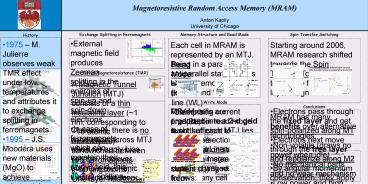Research Poster 24 x 48 A PowerPoint PPT Presentation
1 / 1
Title: Research Poster 24 x 48 A
1
Magnetoresistive Random Access Memory (MRAM)
Anton Kapliy University of Chicago
Exchange Splitting in Ferromagnets
Spin Transfer Switching
Memory Structure and Read Mode
History
- 1975 M. Julierre observes weak TMR effect under
low temperatures and attributes it to exchange
splitting in ferromagnets - 1995 J.S. Moodera uses new materials (MgO) to
achieve substantial TMR at room temperatures - 2000 Freescale, IBM, Infineon et al initiate
programs to commerialize the technology - 2006 - present commercial availability.
- Today 1 MB costs gt 1, development proceeds
Each cell in MRAM is represented by an MTJ. Being
in a parallel or antiparallel state defines
binary memory states 0 (low R) and 1 (high
R). MRAM cells are organized into a 2-d grid
such that each MTJ lies at the intersection of a
Word/Digit Line and a Bit Line (see image on the
left). This way we can address any cell of
interest.
- Starting around 2006, MRAM research shifted
towards the Spin Transfer Toque technique for
changing layer magnetization. - Electrons pass through the fixed layer and get
spin-polarized along M1 - Electrons next move through the free layer and
repolarize along M2 - By angular momentum conservation, they apply a
torque on electrons in the free layer, so that
their spin turns in the direction of M1 - With sufficient current, free layer becomes
polarized parallel to M1 - Since spin transfer method doesnt require a
strong externally-generated B-field, it promises
lower power consumption and better scalability.
- External magnetic field produces Zeeman splitting
in the energies of spin-up and spin-down
electrons. - In case of ferromagnets, which can maintain their
own B-field, this energy splitting can occur
without any external field. This so-called
exchange splitting can be on the order of an eV,
and explains unequal density of states of
electrons with different spins near Fermi surface
- Read Mode
- Activate the word line (WL)
- Clamp bit line (BL) to fixed voltage
- Transistor will sink a current (IR) from
collector to emitter - Compare that current to reference
Total torque on M2 for different spin torques
Note that spin torque is proportional to current
Tunnel Magnetoresistance (TMR)
- Classically, there is no conduction across MTJ
when we apply bias voltage. However, quantum
mechanically, electrons can tunnel through the
barrier. - To a good approximation, this process can be
described in terms of Julierres two-current
model - Different spins tunnel independently the
probability for an electron to tunnel and change
its spin is a 2nd order effect. - Electrons near Fermi level account for the
majority of tunneling since they are the most
energetic - Tunneling probability is proportional to density
of states near Fermi level according to Fermis
Golden rule - If two magnetizations are parallel, majority
spins (?) tunnel to majority states and account
for most of the conduction. Minority spins (?)
tunnel to minority states and have negligible
conduction. - If two magnetizations are antiparallel, majority
spins (?) tunnel to minority states, while
minority spins (?) tunnel to majority states.
Thus, both channels are suppressed, resulting in
low overall conduction. - Mathematically, we can compute the TMR ratio as
follows
A Magnetic Tunnel Junction (MTJ) consists of a
thin insulating layer (1 nm, corresponding to
10 atomic monolayers) sandwiched between two
ferromagnets (50 angstroms). One layer has
frozen magnetization, and the other is free to
change.
Write Mode
Conclusions
- The sensing current produced in read mode is not
sufficient to change the magnetization state of
free layer. Instead, the state is changed as
follows - Send a unidirectional (hard) current through
the digit line. - Send a bi-directional (soft) current through
the bit line - Turn the isolation transistor off so that no
current flows through the junction during write
cycle - Use ferromagnetic material with such coercivity
that the switching doesnt occur when exposed to
B-field from one line only.
- MRAM has many benefits over alternative
technologies - Non-volatile (draws no power when idle)
- No mechanical parts and no wear mechanism
- Low power and high density
- Much faster than Flash memory
- However, it still faces many challenges
- Requires good material uniformity (e.g., for
small MTJ resistance variation) - Close packing reduces switching barrier prone to
thermal auto-switching - B-field from neighboring locations starts to
interfere as size is reduced - Low adoption, and as a consequence, high prices
Sketch of state switching
References
Reversal gap between states vs switch fields
- Physics Review, Volume 168, N2 531 (1968)
Spin-disorder scattering and magnetoresistance of
magnetic semiconductors - J.M. De Teresa et al, Role of the Barrier in
Magnetic Tunnel Junctions - JOM-e 52(6) (2000) (J.M. Slaughter et al)
Magnetic Tunnel Junction Materials for Electronic
Applications - Freescale Semiconductor website materials
(http//www.freescale.com/) - Industrial Embedded Systems (magazine) Magnetic
Tunnel Junction sensor development for industrial
applications - H. Kimura et al - A Study of Multiple-Valued MRAM
Using Binary MTJ Devices - Wikipedia.org (to review many relevant concepts)
- Plus half-a-dozen other academic and industrial
papers/datasheets
Device model from Freescale
Phase space of switch fields
(spin polarization)
Hysteresis curve Remanence and Coercivity

